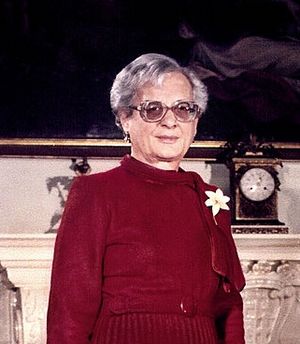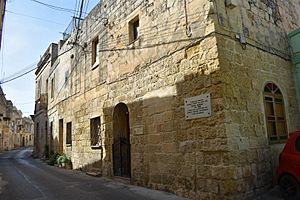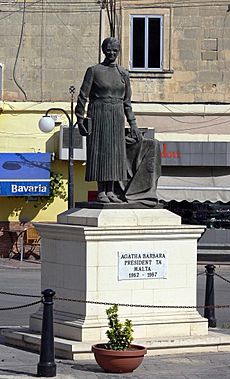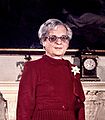Agatha Barbara facts for kids
Quick facts for kids
Agatha Barbara
|
|
|---|---|
 |
|
| 3rd President of Malta | |
| In office 15 February 1982 – 15 February 1987 |
|
| Prime Minister | Dom Mintoff Karmenu Mifsud Bonnici |
| Preceded by | Albert Hyzler (Acting); Anton Buttigieg |
| Succeeded by | Paul Xuereb (Acting); Ċensu Tabone |
| Personal details | |
| Born | 11 March 1923 Żabbar, Malta |
| Died | 4 February 2002 (aged 78) Żabbar, Malta |
| Resting place | Żabbar Cemetery |
| Political party | Labour Party |
| Awards | |
Agatha Barbara (born March 11, 1923 – died February 4, 2002) was an important Maltese politician. She was a Labour Member of Parliament and a Minister. She made history as the first woman to become president of Malta. She also holds the record for being the longest-serving woman Member of Parliament in Maltese political history.
Contents
Early Life and Education

Agatha Barbara was born in Żabbar, Malta, in 1923. Her father worked for the Royal Navy as a tug master, which is someone who skillfully guides tugboats. He earned very little money. Her mother found it hard to feed their nine children on his small wages. Agatha was the second child and the oldest daughter in the family.
She really wanted to go to school and begged her parents to send her. She attended grammar school in Valletta. During World War II, she worked as an air raid warden. This meant she helped supervise kitchens set up by the British military to feed people during bombings. After the war, she became a school teacher. She then became very interested in politics. She joined the Malta Labour Party (MLP) and was very active. She became a member of the MLP's main committee. She also led the party's women's group and started the Women's Political Movement in Malta.
A Trailblazer in Politics
From 1947, Malta had some control over its own government. At this time, women in Malta did not have the right to vote. The Women of Malta Association and the Malta Labour Party pushed for women to get voting rights. This idea faced strong opposition, especially from the Church. However, the proposal was finally accepted by a small number of votes.
These disagreements made Agatha Barbara even more determined to show what women could do. When people encouraged her, she decided to run for election in 1947. She won and became the first and only woman among the 40 Members of Parliament. She was also the only woman to win ten elections in a row. She kept winning until 1982, when she stepped down to become president.
Agatha Barbara was known for supporting changes that helped people economically and socially. She was Malta's first woman cabinet minister. She held this important role for many years.
Minister of Education
When the Labour Party first came to power in 1955, Agatha Barbara became the minister of education. She was appointed by Dom Mintoff. During this time, from 1955 to 1958, she made many big changes. She made sure that all children had to go to school full-time. She also set up a college to train teachers and special schools for children with disabilities. Secondary school became free for everyone. She also made sure that both girls and boys could take science classes.
In 1958, there were problems between the British and the Maltese. Protests happened in the streets, and Mintoff resigned. Agatha Barbara took part in these protests. She was sentenced to 43 days of "hard labour" as a result.
When Mintoff became prime minister again in 1971, Agatha Barbara was once more appointed minister of education. She continued her work to improve schooling. She made basic education compulsory until the age of 16, instead of 14. She also created trade and technical schools. University fees were removed, making higher education more accessible.
Minister for Labour, Culture, and Welfare
In 1974, Agatha Barbara became the minister for labour, culture, and welfare. In this role, she worked hard to reduce the number of people without jobs. She also improved workers' pay and working conditions. She introduced a law that made sure women and men received equal pay for the same work. She also brought in paid time off for new mothers. She helped create a 40-hour work week. She also worked on retirement and unemployment benefits to help people.
Beyond her work in education and labour, she also helped set up several national museums. She played a key role in restoring old buildings in Mdina and Valletta. She wanted these historic places to be used as museums for everyone to enjoy.
In 1976, Agatha Barbara became the deputy leader of the Labour Party's group in parliament. She also served as deputy prime minister for short periods, stepping in for Mintoff.
Presidency of Malta
In 1981, an election caused a big problem for Malta's government. The Nationalist Party (PN) won more votes, but the Labour Party (MLP) got more seats in parliament. The PN refused to take their seats and organized protests. Even so, Mintoff formed a government. Instead of becoming a minister again, Agatha Barbara was chosen to be the first woman president of Malta. She was 59 years old when she took office on February 15, 1982. She was the third President of the Republic.
Usually, the president's job was mostly ceremonial, like a symbol for the country. But Agatha Barbara's main task was to help solve this government crisis. At the end of her time as president in 1987, she oversaw important changes to Malta's Constitution. These changes made Malta's independence from other countries stronger. They also made sure that if a party won the most votes in an election, they would get enough seats in parliament to form a government.
After her term ended in 1987, she retired from politics. Agatha Barbara's picture appeared on some Maltese banknotes issued in 1986. She returned to her hometown of Żabbar, where she passed away in 2002. A monument was built in her honour in Żabbar. It was unveiled on April 23, 2006, by the then President of Malta, Dr. Edward Fenech Adami.
Images for kids
See also
 In Spanish: Agatha Barbara para niños
In Spanish: Agatha Barbara para niños





